height BMW 745LI 2002 E66 Level Control System Manual
[x] Cancel search | Manufacturer: BMW, Model Year: 2002, Model line: 745LI, Model: BMW 745LI 2002 E66Pages: 57, PDF Size: 1.89 MB
Page 23 of 57
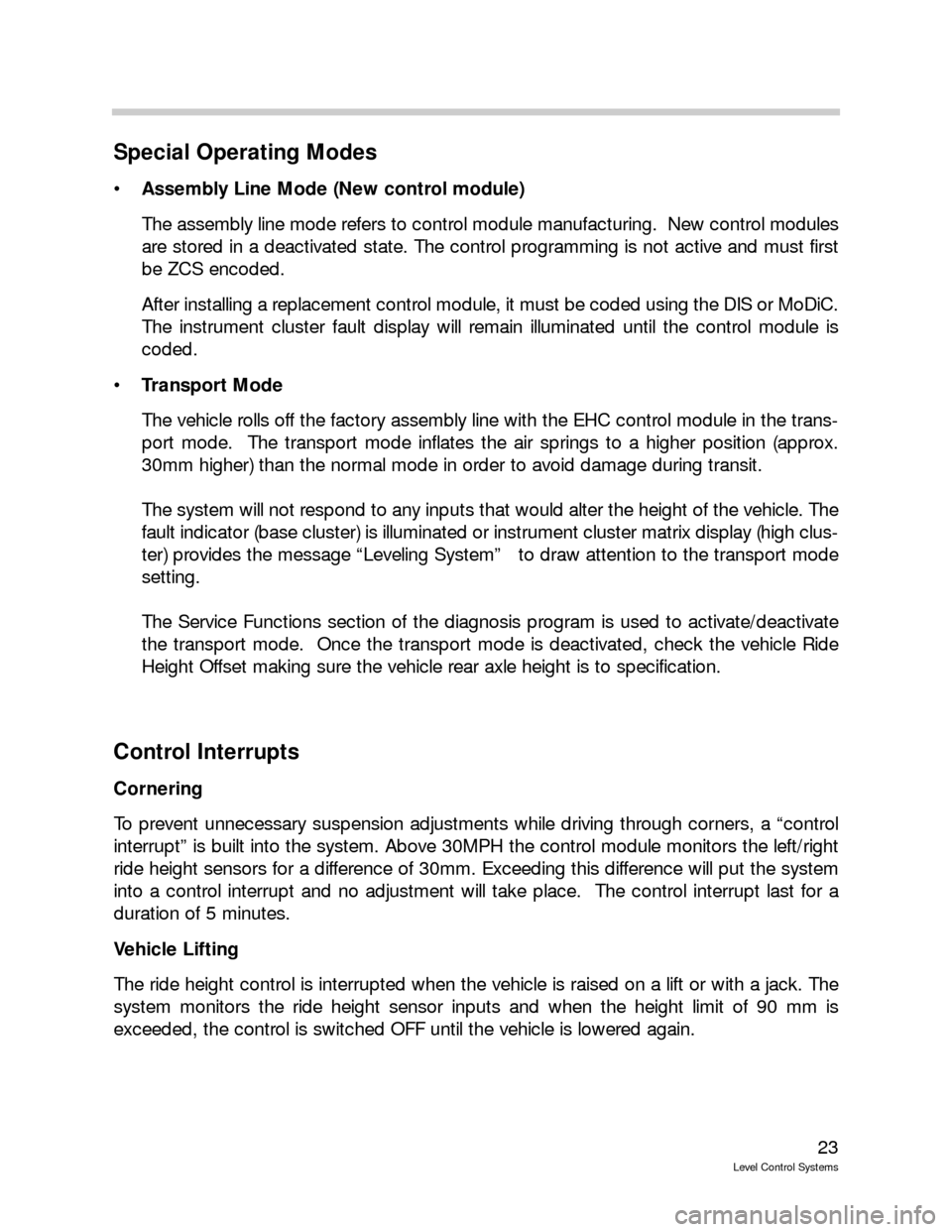
23
Level Control Systems
Special Operating Modes
Assembly Line Mode (New control module)
The assembly line mode refers to control module manufacturing. New control modules
are stored in a deactivated state. The control programming is not active and must first
be ZCS encoded.
After installing a replacement control module, it must be coded using the DIS or MoDiC.
The instrument cluster fault display will remain illuminated until the control module is
coded.
Transport Mode
The vehicle rolls off the factory assembly line with the EHC control module in the trans-
port mode. The transport mode inflates the air springs to a higher position (approx.
30mm higher) than the normal mode in order to avoid damage during transit.
The system will not respond to any inputs that would alter the height of the vehicle. The
fault indicator (base cluster) is illuminated or instrument cluster matrix display (high clus-
ter) provides the message “Leveling System” to draw attention to the transport mode
setting.
The Service Functions section of the diagnosis program is used to activate/deactivate
the transport mode. Once the transport mode is deactivated, check the vehicle Ride
Height Offset making sure the vehicle rear axle height is to specification.
Control Interrupts
Cornering
To prevent unnecessary suspension adjustments while driving through corners, a “control
interrupt” is built into the system. Above 30MPH the control module monitors the left/right
ride height sensors for a difference of 30mm. Exceeding this difference will put the system
into a control interrupt and no adjustment will take place. The control interrupt last for a
duration of 5 minutes.
Vehicle Lifting
The ride height control is interrupted when the vehicle is raised on a lift or with a jack. The
system monitors the ride height sensor inputs and when the height limit of 90 mm is
exceeded, the control is switched OFF until the vehicle is lowered again.
Page 25 of 57
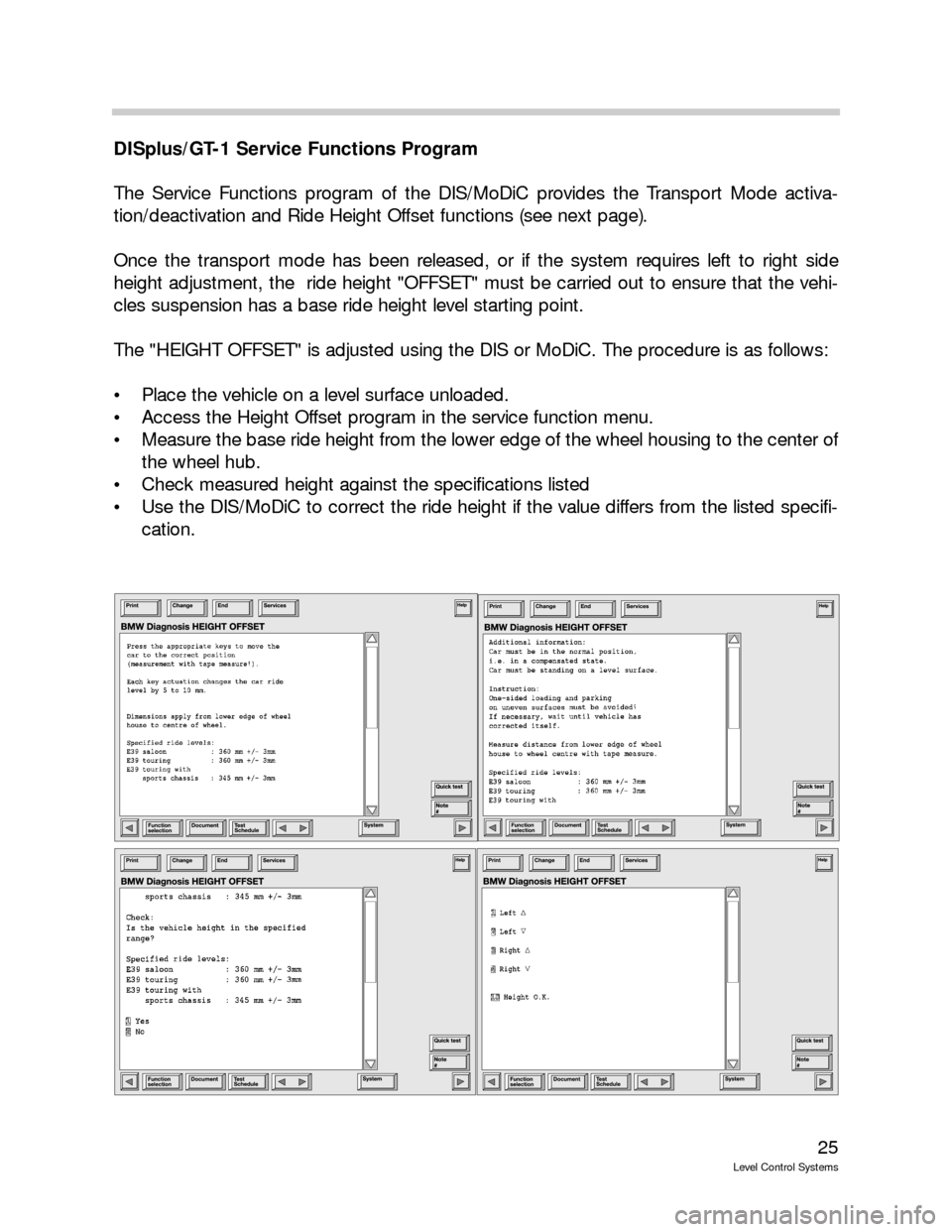
25
Level Control Systems
DISplus/GT-1 Service Functions Program
The Service Functions program of the DIS/MoDiC provides the Transport Mode activa-
tion/deactivation and Ride Height Offset functions (see next page).
Once the transport mode has been released, or if the system requires left to right side
height adjustment, the ride height "OFFSET" must be carried out to ensure that the vehi-
cles suspension has a base ride height level starting point.
The "HEIGHT OFFSET" is adjusted using the DIS or MoDiC. The procedure is as follows:
Place the vehicle on a level surface unloaded.
Access the Height Offset program in the service function menu.
Measure the base ride height from the lower edge of the wheel housing to the center of
the wheel hub.
Check measured height against the specifications listed
Use the DIS/MoDiC to correct the ride height if the value differs from the listed specifi-
cation.
Page 27 of 57
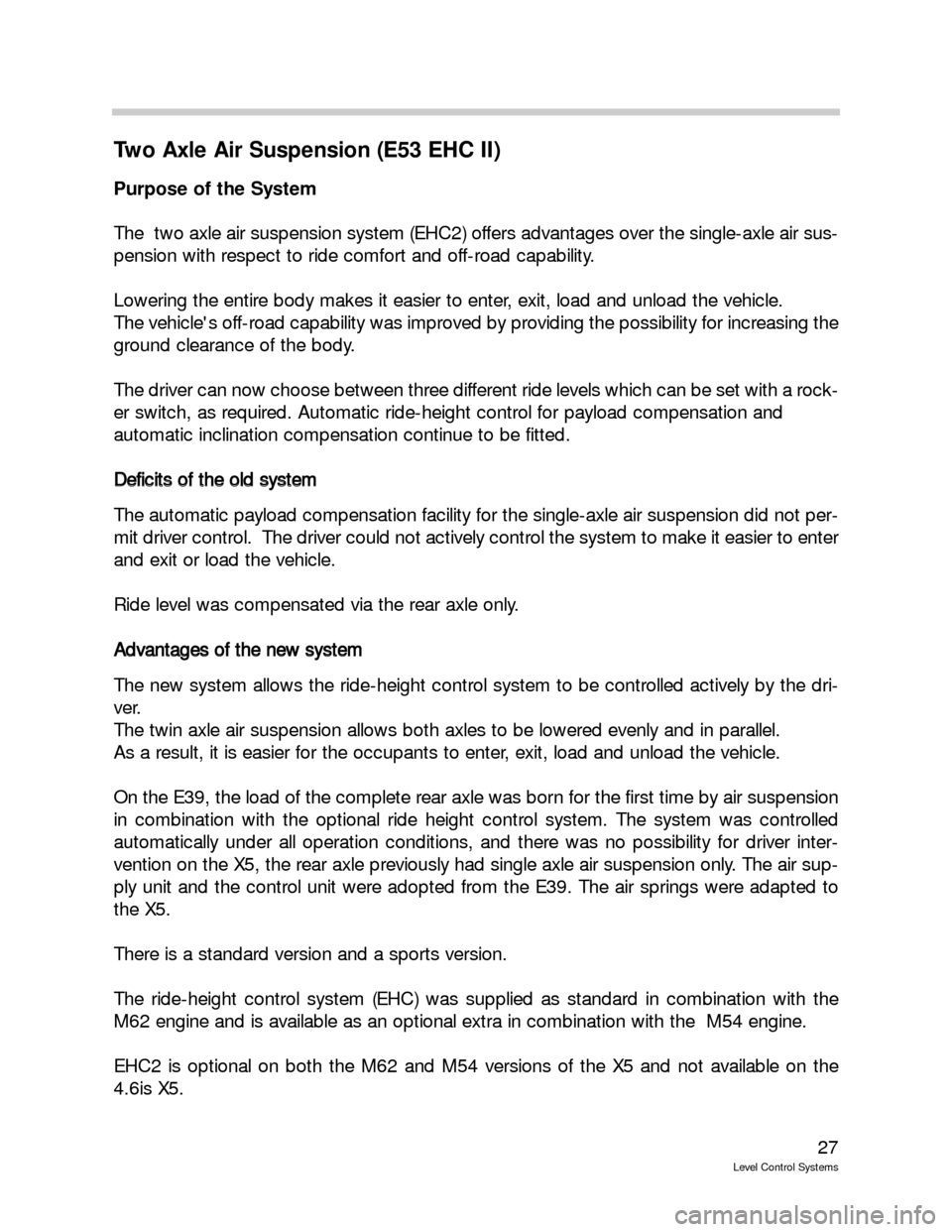
27
Level Control Systems
Two Axle Air Suspension (E53 EHC II)
Purpose of the System
The two axle air suspension system (EHC2) offers advantages over the single-axle air sus-
pension with respect to ride comfort and off-road capability.
Lowering the entire body makes it easier to enter, exit, load and unload the vehicle.
The vehicle's off-road capability was improved by providing the possibility for increasing the
ground clearance of the body.
The driver can now choose between three different ride levels which can be set with a rock-
er switch, as required. Automatic ride-height control for payload compensation and
automatic inclination compensation continue to be fitted.
D De
ef
fi
ic
ci
it
ts
s
o
of
f
t
th
he
e
o
ol
ld
d
s
sy
ys
st
te
em
m
The automatic payload compensation facility for the single-axle air suspension did not per-
mit driver control. The driver could not actively control the system to make it easier to enter
and exit or load the vehicle.
Ride level was compensated via the rear axle only.
A Ad
dv
va
an
nt
ta
ag
ge
es
s
o
of
f
t
th
he
e
n
ne
ew
w
s
sy
ys
st
te
em
m
The new system allows the ride-height control system to be controlled actively by the dri-
ver.
The twin axle air suspension allows both axles to be lowered evenly and in parallel.
As a result, it is easier for the occupants to enter, exit, load and unload the vehicle.
On the E39, the load of the complete rear axle was born for the first time by air suspension
in combination with the optional ride height control system. The system was controlled
automatically under all operation conditions, and there was no possibility for driver inter-
vention on the X5, the rear axle previously had single axle air suspension only. The air sup-
ply unit and the control unit were adopted from the E39. The air springs were adapted to
the X5.
There is a standard version and a sports version.
The ride-height control system (EHC) was supplied as standard in combination with the
M62 engine and is available as an optional extra in combination with the M54 engine.
EHC2 is optional on both the M62 and M54 versions of the X5 and not available on the
4.6is X5.
Page 28 of 57
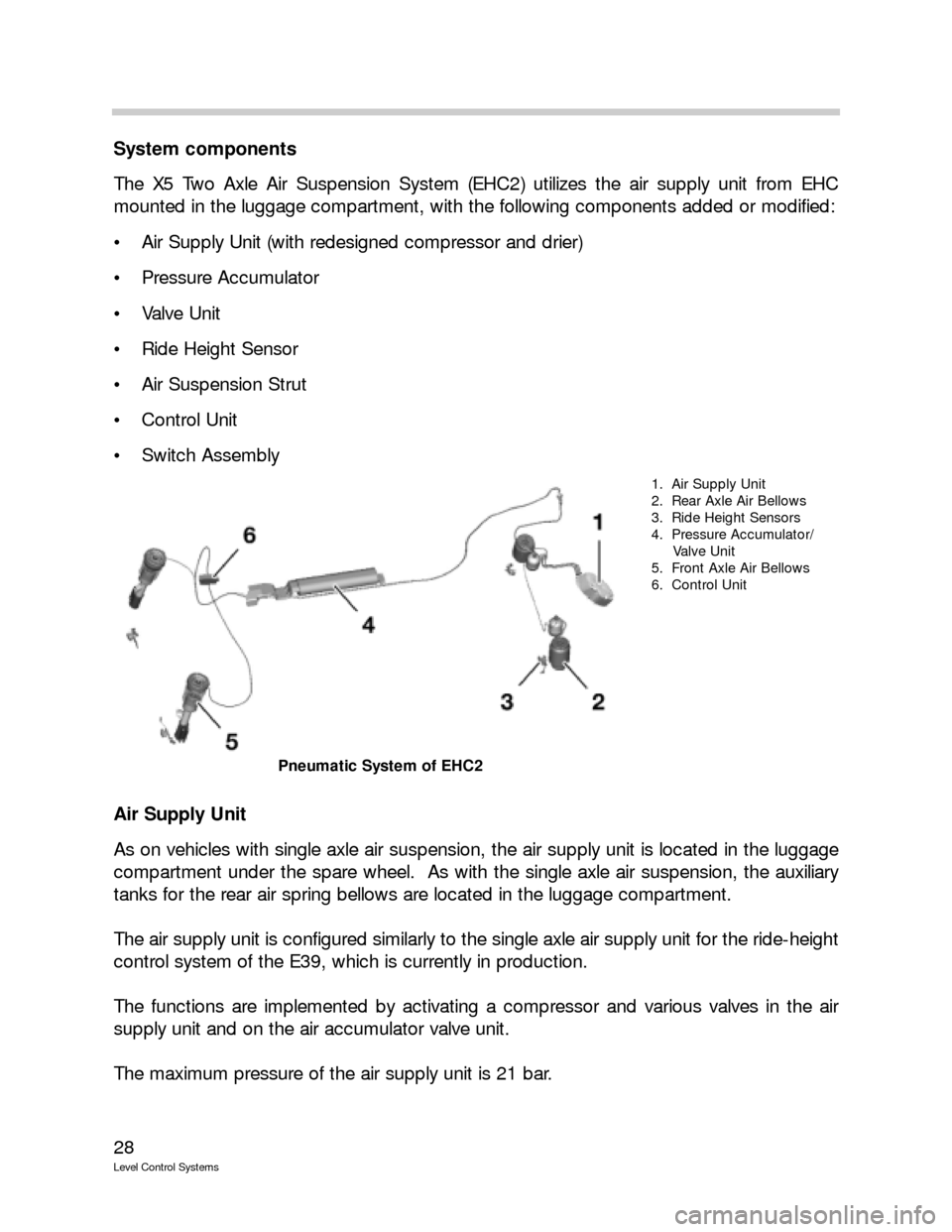
28
Level Control Systems
System components
The X5 Two Axle Air Suspension System (EHC2) utilizes the air supply unit from EHC
mounted in the luggage compartment, with the following components added or modified:
Air Supply Unit (with redesigned compressor and drier)
Pressure Accumulator
Valve Unit
Ride Height Sensor
Air Suspension Strut
Control Unit
Switch Assembly
Air Supply Unit
As on vehicles with single axle air suspension, the air supply unit is located in the luggage
compartment under the spare wheel. As with the single axle air suspension, the auxiliary
tanks for the rear air spring bellows are located in the luggage compartment.
The air supply unit is configured similarly to the single axle air supply unit for the ride-height
control system of the E39, which is currently in production.
The functions are implemented by activating a compressor and various valves in the air
supply unit and on the air accumulator valve unit.
The maximum pressure of the air supply unit is 21 bar.
1. Air Supply Unit
2. Rear Axle Air Bellows
3. Ride Height Sensors
4. Pressure Accumulator/
Valve Unit
5. Front Axle Air Bellows
6. Control Unit
Pneumatic System of EHC2
Page 31 of 57
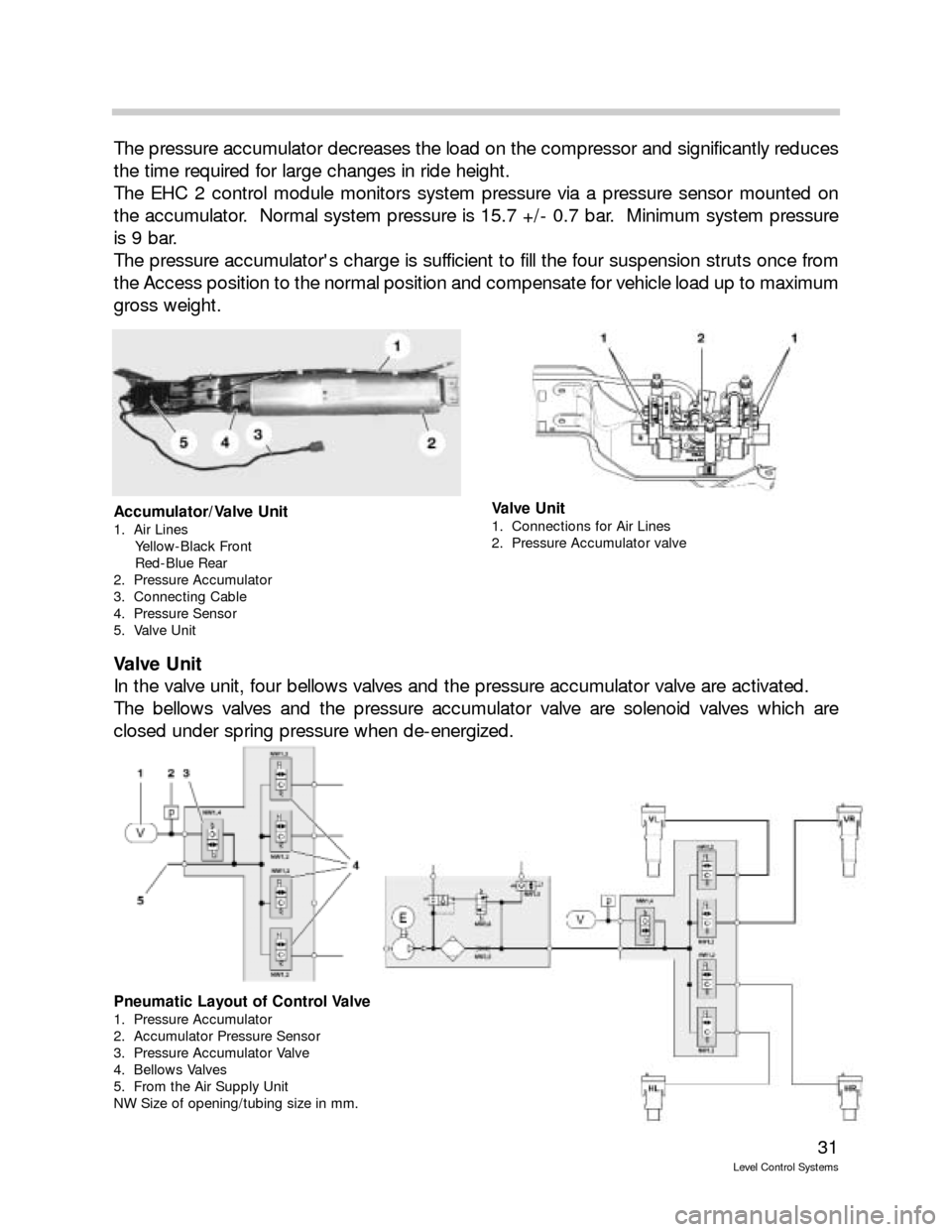
31
Level Control Systems
The pressure accumulator decreases the load on the compressor and significantly reduces
the time required for large changes in ride height.
The EHC 2 control module monitors system pressure via a pressure sensor mounted on
the accumulator. Normal system pressure is 15.7 +/- 0.7 bar. Minimum system pressure
is 9 bar.
The pressure accumulator's charge is sufficient to fill the four suspension struts once from
the Access position to the normal position and compensate for vehicle load up to maximum
gross weight.
Valve Unit
In the valve unit, four bellows valves and the pressure accumulator valve are activated.
The bellows valves and the pressure accumulator valve are solenoid valves which are
closed under spring pressure when de-energized.
Accumulator/Valve Unit
1. Air Lines
Yellow-Black Front
Red-Blue Rear
2. Pressure Accumulator
3. Connecting Cable
4. Pressure Sensor
5. Valve Unit
Valve Unit
1. Connections for Air Lines
2. Pressure Accumulator valve
Pneumatic Layout of Control Valve
1. Pressure Accumulator
2. Accumulator Pressure Sensor
3. Pressure Accumulator Valve
4. Bellows Valves
5. From the Air Supply Unit
NW Size of opening/tubing size in mm.
Page 32 of 57
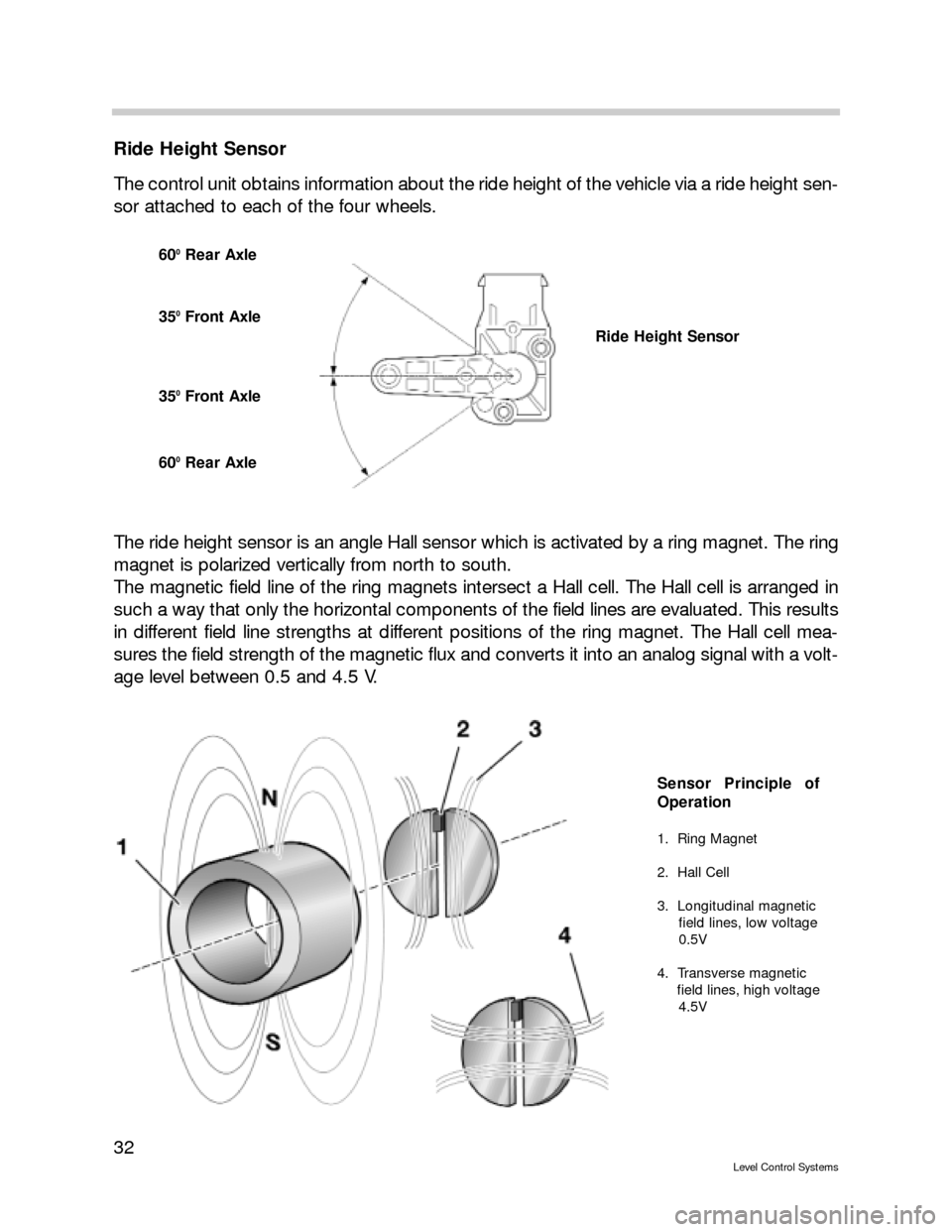
32
Level Control Systems
Ride Height Sensor
The control unit obtains information about the ride height of the vehicle via a ride height sen-
sor attached to each of the four wheels.
The ride height sensor is an angle Hall sensor which is activated by a ring magnet. The ring
magnet is polarized vertically from north to south.
The magnetic field line of the ring magnets intersect a Hall cell. The Hall cell is arranged in
such a way that only the horizontal components of the field lines are evaluated. This results
in different field line strengths at different positions of the ring magnet. The Hall cell mea-
sures the field strength of the magnetic flux and converts it into an analog signal with a volt-
age level between 0.5 and 4.5 V.
600Rear Axle
350Front Axle
350Front Axle
600Rear Axle
Ride Height Sensor
Sensor Principle of
Operation
1. Ring Magnet
2. Hall Cell
3. Longitudinal magnetic
field lines, low voltage
0.5V
4. Transverse magnetic
field lines, high voltage
4.5V
Page 33 of 57
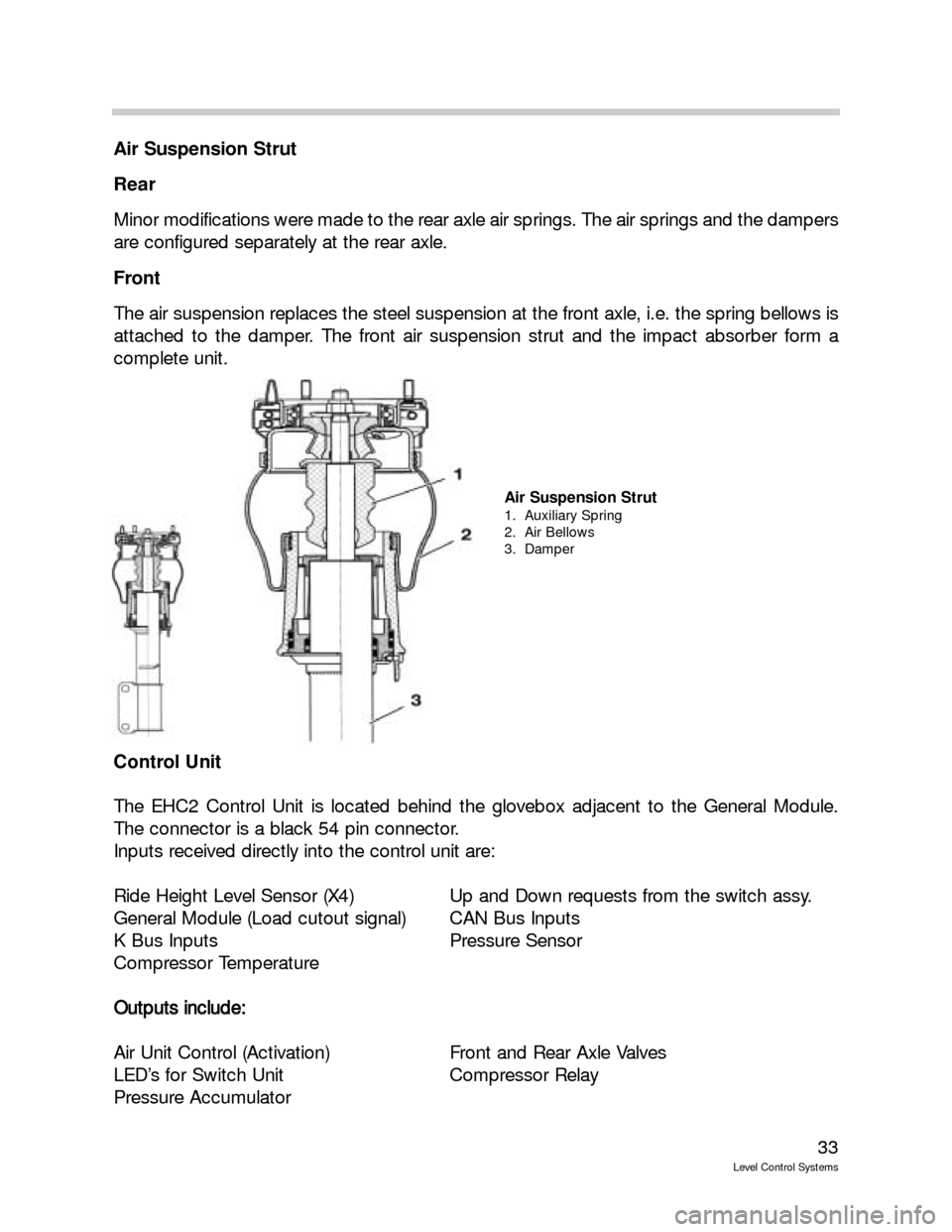
33
Level Control Systems
Air Suspension Strut
Rear
Minor modifications were made to the rear axle air springs. The air springs and the dampers
are configured separately at the rear axle.
Front
The air suspension replaces the steel suspension at the front axle, i.e. the spring bellows is
attached to the damper. The front air suspension strut and the impact absorber form a
complete unit.
Control Unit
The EHC2 Control Unit is located behind the glovebox adjacent to the General Module.
The connector is a black 54 pin connector.
Inputs received directly into the control unit are:
Ride Height Level Sensor (X4) Up and Down requests from the switch assy.
General Module (Load cutout signal) CAN Bus Inputs
K Bus Inputs Pressure Sensor
Compressor Temperature
O Ou
ut
tp
pu
ut
ts
s
i
in
nc
cl
lu
ud
de
e:
:
Air Unit Control (Activation) Front and Rear Axle Valves
LED’s for Switch Unit Compressor Relay
Pressure Accumulator
Air Suspension Strut
1. Auxiliary Spring
2. Air Bellows
3. Damper
Page 34 of 57
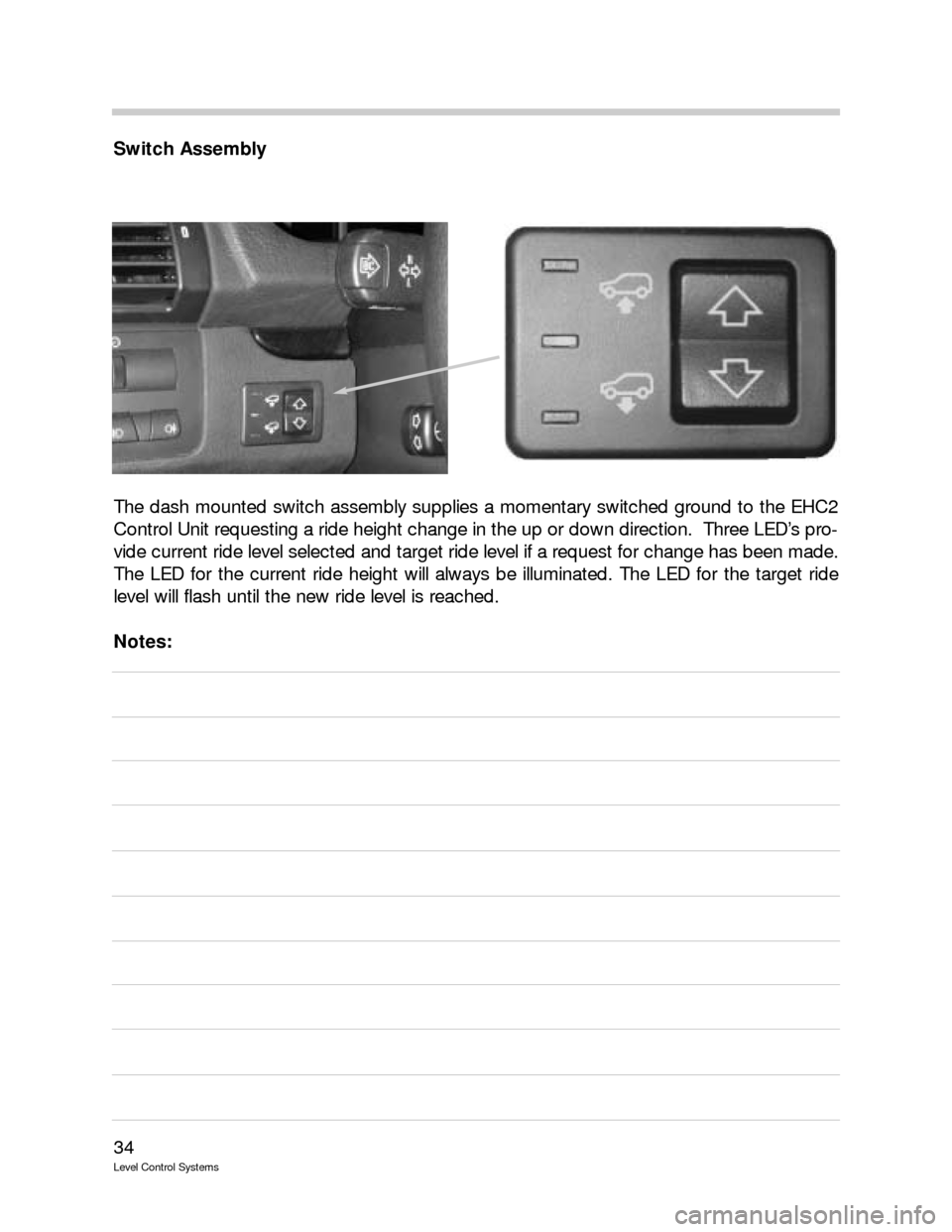
34
Level Control Systems
Switch Assembly
The dash mounted switch assembly supplies a momentary switched ground to the EHC2
Control Unit requesting a ride height change in the up or down direction. Three LED’s pro-
vide current ride level selected and target ride level if a request for change has been made.
The LED for the current ride height will always be illuminated. The LED for the target ride
level will flash until the new ride level is reached.
Notes:
Page 35 of 57
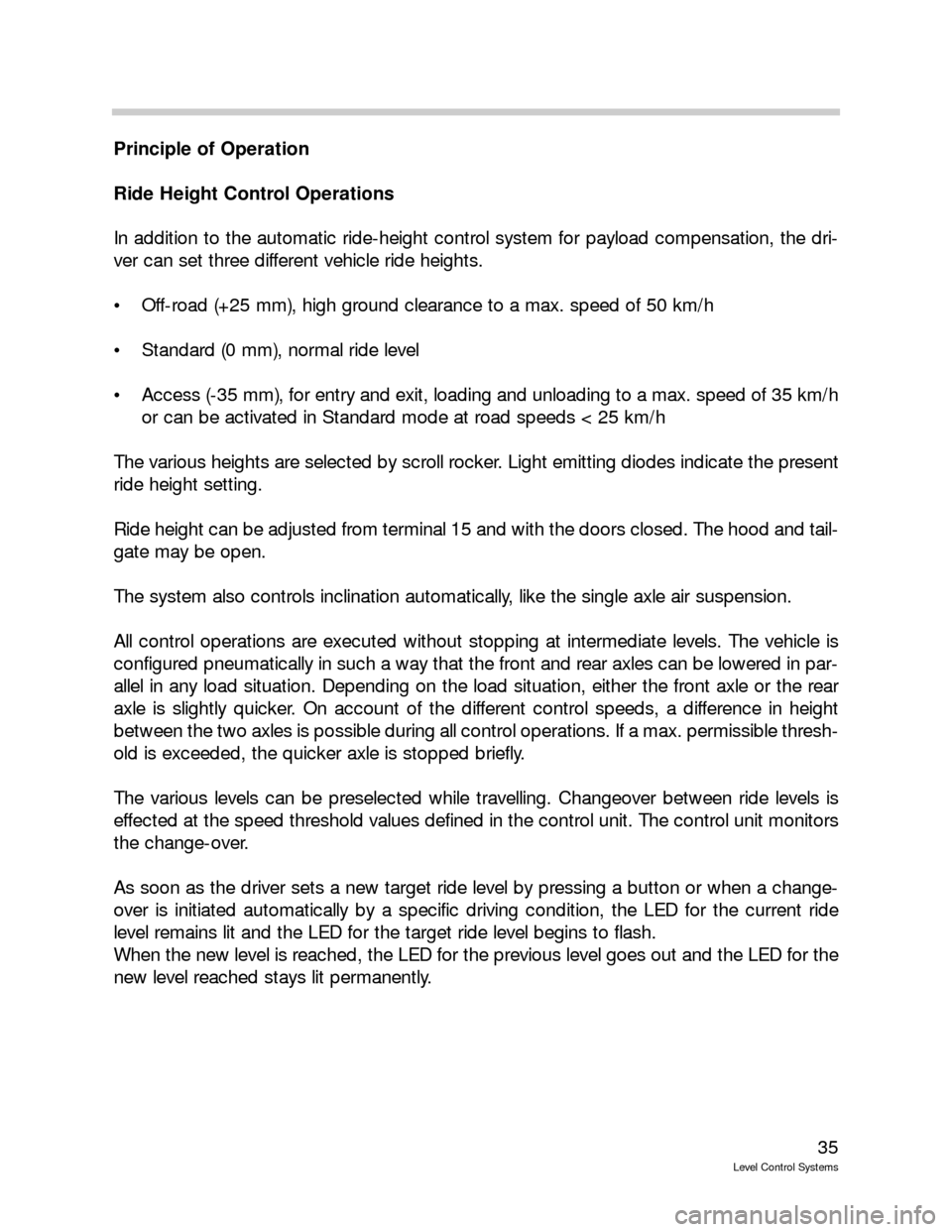
35
Level Control Systems
Principle of Operation
Ride Height Control Operations
In addition to the automatic ride-height control system for payload compensation, the dri-
ver can set three different vehicle ride heights.
Off-road (+25 mm), high ground clearance to a max. speed of 50 km/h
Standard (0 mm), normal ride level
Access (-35 mm), for entry and exit, loading and unloading to a max. speed of 35 km/h
or can be activated in Standard mode at road speeds < 25 km/h
The various heights are selected by scroll rocker. Light emitting diodes indicate the present
ride height setting.
Ride height can be adjusted from terminal 15 and with the doors closed. The hood and tail-
gate may be open.
The system also controls inclination automatically, like the single axle air suspension.
All control operations are executed without stopping at intermediate levels. The vehicle is
configured pneumatically in such a way that the front and rear axles can be lowered in par-
allel in any load situation. Depending on the load situation, either the front axle or the rear
axle is slightly quicker. On account of the different control speeds, a difference in height
between the two axles is possible during all control operations. If a max. permissible thresh-
old is exceeded, the quicker axle is stopped briefly.
The various levels can be preselected while travelling. Changeover between ride levels is
effected at the speed threshold values defined in the control unit. The control unit monitors
the change-over.
As soon as the driver sets a new target ride level by pressing a button or when a change-
over is initiated automatically by a specific driving condition, the LED for the current ride
level remains lit and the LED for the target ride level begins to flash.
When the new level is reached, the LED for the previous level goes out and the LED for the
new level reached stays lit permanently.
Page 37 of 57
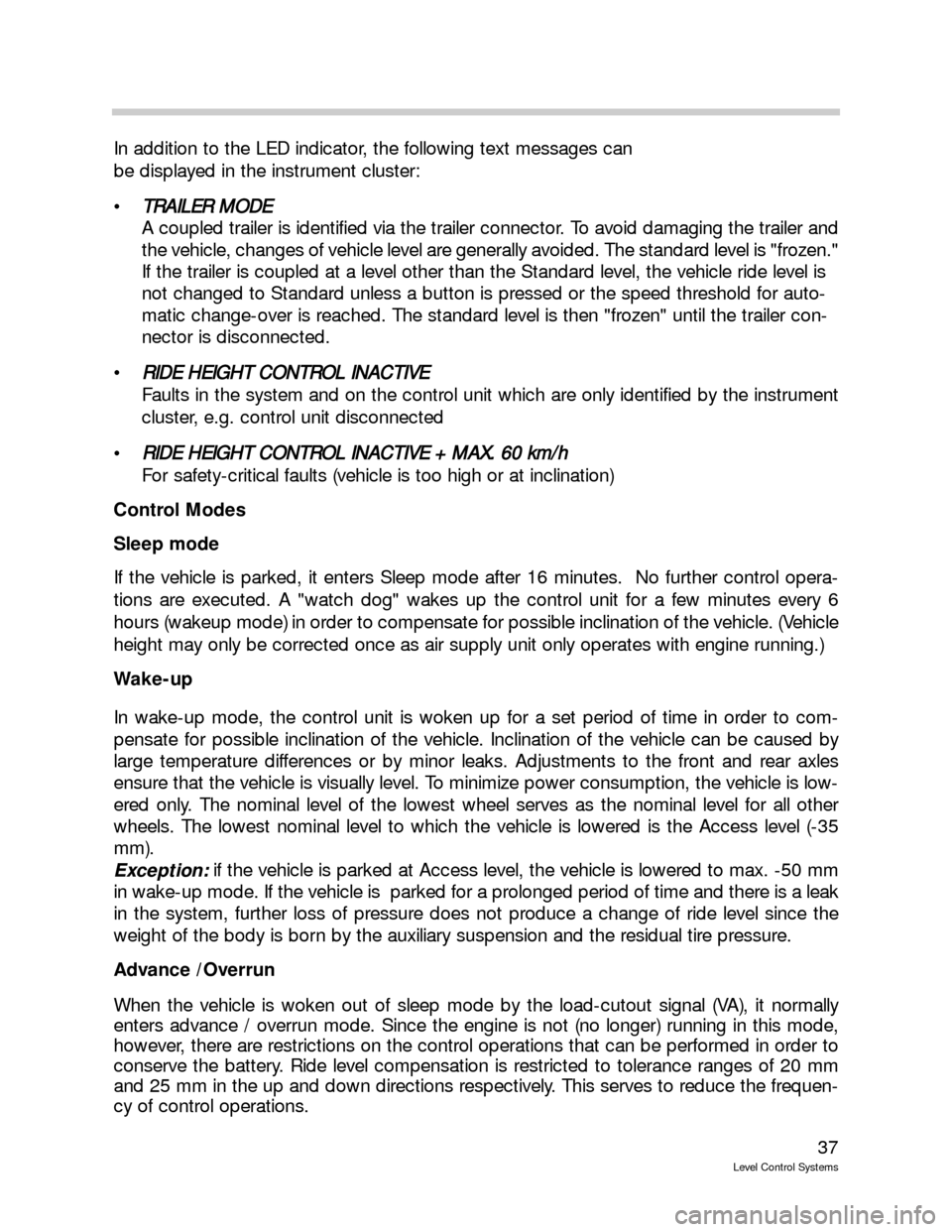
37
Level Control Systems
In addition to the LED indicator, the following text messages can
be displayed in the instrument cluster:
T TR
RA
AI
IL
LE
ER
R
M
MO
OD
DE
E
A coupled trailer is identified via the trailer connector. To avoid damaging the trailer and
the vehicle, changes of vehicle level are generally avoided. The standard level is "frozen."
If the trailer is coupled at a level other than the Standard level, the vehicle ride level is
not changed to Standard unless a button is pressed or the speed threshold for auto-
matic change-over is reached. The standard level is then "frozen" until the trailer con-
nector is disconnected.
R RI
ID
DE
E
H
HE
EI
IG
GH
HT
T
C
CO
ON
NT
TR
RO
OL
L
I
IN
NA
AC
CT
TI
IV
VE
E
Faults in the system and on the control unit which are only identified by the instrument
cluster, e.g. control unit disconnected
R RI
ID
DE
E
H
HE
EI
IG
GH
HT
T
C
CO
ON
NT
TR
RO
OL
L
I
IN
NA
AC
CT
TI
IV
VE
E
+
+
M
MA
AX
X.
.
6
60
0
k
km
m/
/h
h
For safety-critical faults (vehicle is too high or at inclination)
Control Modes
Sleep mode
If the vehicle is parked, it enters Sleep mode after 16 minutes. No further control opera-
tions are executed. A "watch dog" wakes up the control unit for a few minutes every 6
hours (wakeup mode) in order to compensate for possible inclination of the vehicle. (Vehicle
height may only be corrected once as air supply unit only operates with engine running.)
Wake-up
In wake-up mode, the control unit is woken up for a set period of time in order to com-
pensate for possible inclination of the vehicle. Inclination of the vehicle can be caused by
large temperature differences or by minor leaks. Adjustments to the front and rear axles
ensure that the vehicle is visually level. To minimize power consumption, the vehicle is low-
ered only. The nominal level of the lowest wheel serves as the nominal level for all other
wheels. The lowest nominal level to which the vehicle is lowered is the Access level (-35
mm).
Exception:if the vehicle is parked at Access level, the vehicle is lowered to max. -50 mm
in wake-up mode. If the vehicle is parked for a prolonged period of time and there is a leak
in the system, further loss of pressure does not produce a change of ride level since the
weight of the body is born by the auxiliary suspension and the residual tire pressure.
Advance /Overrun
When the vehicle is woken out of sleep mode by the load-cutout signal (VA), it normally
enters advance / overrun mode. Since the engine is not (no longer) running in this mode,
however, there are restrictions on the control operations that can be performed in order to
conserve the battery. Ride level compensation is restricted to tolerance ranges of 20 mm
and 25 mm in the up and down directions respectively. This serves to reduce the frequen-
cy of control operations.